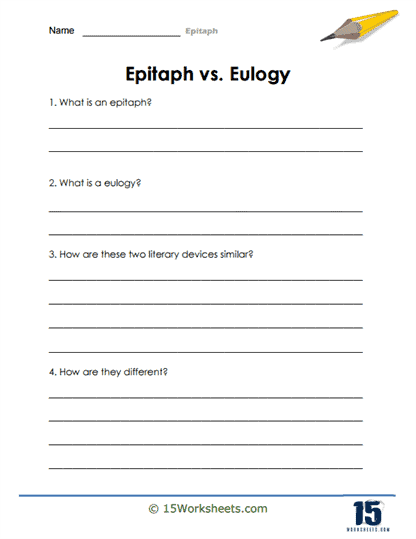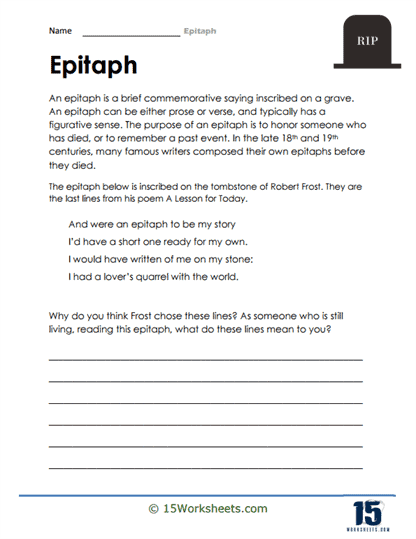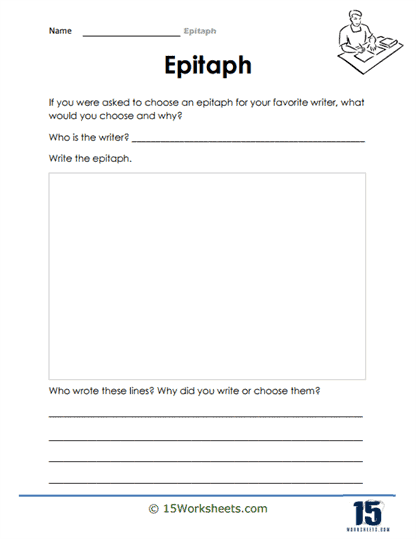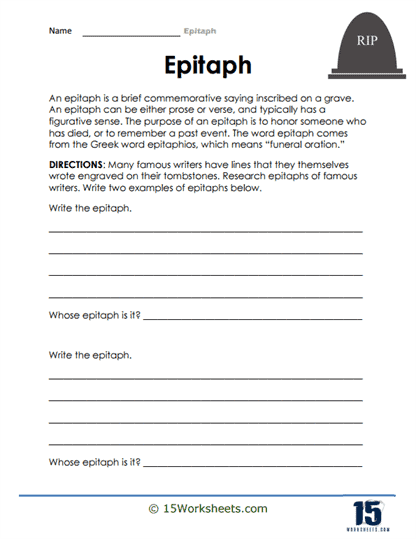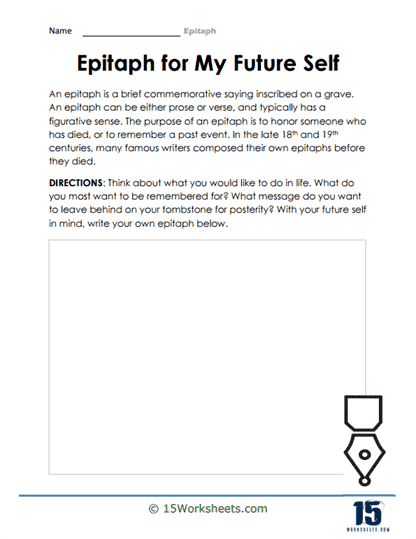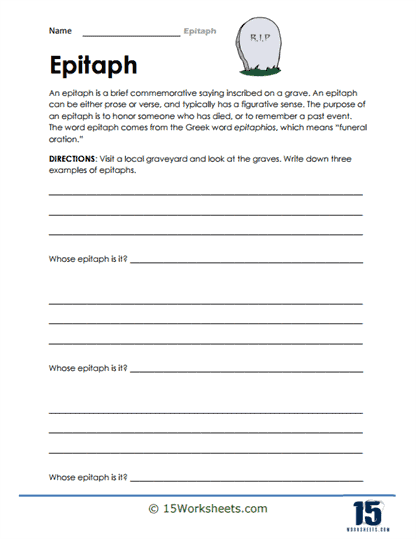Epitaph Worksheets
About These 15 Worksheets
Epitaph worksheets are educational tools designed to enhance students’ understanding of epitaphs, which are short texts commemorating the deceased, typically found on tombstones. These worksheets aim to develop students’ comprehension and appreciation of this unique literary form, its historical significance, and its cultural variations. By engaging with epitaph worksheets, students delve into the nuances of concise writing, explore themes of legacy and memory, and refine their analytical, creative, and interpretive skills in language arts.
Through a variety of exercises, students not only deepen their understanding of this distinctive literary form but also enhance their analytical, creative, and interpretive skills. The practice of engaging with epitaphs fosters an appreciation for the nuances of language, the diversity of human experience, and the universal themes of life, death, and legacy. As students navigate these worksheets, they cultivate a rich set of skills that enrich their academic journey and personal growth in language arts and beyond.
Types of Exercises
Epitaph worksheets comprise a variety of exercises tailored to explore the multifaceted aspects of epitaphs. These exercises include:
Historical Analysis Exercises – Students research and analyze epitaphs from different historical periods and cultures. They examine how epitaphs reflect the values, beliefs, and linguistic styles of their times. This exercise helps students understand the evolution of language and cultural attitudes towards death and remembrance.
Reading Comprehension Exercises – These exercises involve reading and interpreting epitaphs, focusing on their meaning, tone, and the use of literary devices such as metaphor, symbolism, and irony. Students answer questions designed to deepen their understanding of the text and its subtextual elements.
Creative Writing Exercises – Students are tasked with writing their own epitaphs, either for historical figures, fictional characters, or themselves, as a speculative exercise. This encourages creativity, brevity in writing, and reflection on one’s life and legacy. It also allows students to practice empathy by imagining the perspectives of others.
Comparative Analysis Exercises – Students compare epitaphs from different cultures or time periods to identify common themes and differences in expression. This exercise enhances students’ analytical skills and broadens their understanding of how context influences literary forms.
Vocabulary and Language Exercises – These exercises focus on the specific language choices in epitaphs, including diction, connotation, and the power of concise language. Students may explore the etymology of words commonly found in epitaphs, enhancing their vocabulary and appreciation for word choice.
Interpretive Art Exercises – Students create visual art interpretations of epitaphs, translating textual themes into visual media. This interdisciplinary approach fosters a deeper emotional and intellectual engagement with the material.
Discussion and Reflection Exercises – Through guided discussions or reflective writing prompts, students explore their personal reactions to epitaphs, discuss themes of mortality and legacy, and consider the role of epitaphs in contemporary society. This fosters empathy, personal reflection, and critical thinking.
The Benefits
Engaging with epitaph worksheets offers several benefits to students’ development in language arts and reading skills:
Enhanced Analytical Skills – By analyzing epitaphs, students learn to unpack complex ideas expressed concisely, improving their ability to interpret and analyze literary texts. This skill is fundamental across all forms of literature and critical reading.
Improved Writing Skills – The creative writing exercises encourage students to express complex narratives and emotions succinctly, mirroring the brevity required in epitaphs. This practice refines their ability to write clearly and effectively, a valuable skill in both academic and real-world contexts.
Expanded Vocabulary – Exploring the language of epitaphs exposes students to a rich array of vocabulary, including words related to legacy, remembrance, and human experience. Understanding these words in context enhances students’ language proficiency and expressive capabilities.
Cultural Awareness – Comparative analysis exercises broaden students’ perspectives by introducing them to diverse cultural practices surrounding death and remembrance. This fosters a global outlook and cultural sensitivity, essential attributes in today’s interconnected world.
Interdisciplinary Learning – The inclusion of interpretive art exercises encourages students to think beyond traditional linguistic analysis, promoting a holistic understanding of how text and visual elements can convey complex emotions and ideas. This interdisciplinary approach enriches students’ educational experience by integrating art and literature.
Empathy and Reflection – Discussion and reflective writing exercises related to epitaphs engage students with profound themes of life, death, and legacy, encouraging them to reflect on their own lives and the lives of others with empathy and depth. This emotional engagement fosters a deeper connection to literature and its exploration of the human condition.
Public Speaking and Performance Skills – Reading epitaphs aloud, whether in classroom discussions or as part of presentation exercises, helps students develop confidence in their public speaking and performance abilities. Articulating the emotions and themes contained within an epitaph enhances oral communication skills and emotional expressiveness.
What is the Literary Device of Epitaph?
An epitaph is a concise literary device, traditionally inscribed on a tombstone, commemorating the deceased with a brief statement of remembrance, reflection, or tribute. However, its use extends beyond physical memorials into literature, where it serves various thematic and narrative purposes. The primary defining feature of an epitaph is its brevity and focus on honoring or summarizing the life and legacy of a person, whether real or fictional. In literature, epitaphs capture the essence of characters, serve as poignant reflections on life and death, or provide closure to a narrative arc.
Characteristics of an Epitaph
Brevity – Epitaphs are succinct, conveying their message in a few impactful words or sentences. This conciseness is crucial for their effectiveness and memorability.
Reflectiveness – They often reflect on the life, virtues, achievements, or the manner of death of the deceased, offering insights into their character or the values they held dear.
Commemorative Nature – Epitaphs serve to commemorate, celebrating the life of the deceased and serving as a form of tribute or remembrance.
Universal Themes – Though personal and specific, epitaphs frequently touch on universal themes of life, death, legacy, and human nature, resonating with broader audiences.
Tone Variability – The tone of an epitaph can vary widely, from solemn and respectful to humorous and light-hearted, depending on the message the author or the commemorated individual wishes to convey.
Examples of Epitaphs in Literature
Example 1 – “Spoon River Anthology” by Edgar Lee Masters
Edgar Lee Masters’ “Spoon River Anthology” is a collection of poetic epitaphs from fictional residents of Spoon River, a small American town. Each poem serves as an epitaph that reveals the character’s life, struggles, secrets, and reflections from beyond the grave. For instance, the epitaph of Lucinda Matlock speaks of joy, hardship, and the robust embrace of life:
I spun, I wove, I kept the house, I nursed the sick,
I made the garden, and for holiday
Rambled over the fields where sang the larks,
And by Spoon River gathering many a shell,
And many a flower and medicinal weed—
Shouting to the wooded hills, singing to the green valleys.
This epitaph celebrates Lucinda’s life of resilience, joy in nature, and active engagement with her community, offering a model of fulfillment and strength in the face of life’s challenges.
Example 2 – “Hamlet” by William Shakespeare
In Shakespeare’s “Hamlet,” the gravedigger scene includes the contemplation of Yorick’s skull, leading Hamlet to reflect on mortality and the inevitable end that comes to all, regardless of status or accomplishments. Though not an epitaph in the strictest sense, Hamlet’s speech serves an epitaphic function, memorializing Yorick while contemplating the universal nature of death:
Alas, poor Yorick! I knew him, Horatio – a fellow
of infinite jest, of most excellent fancy – he hath
borne me on his back a thousand times; and now, how
abhorred in my imagination it is!
This reflection acts as a verbal epitaph, capturing Yorick’s vivacious spirit and the impact of his life on Hamlet, emphasizing the transience of life and the commonality of death.
Example 3 – “The Adventures of Huckleberry Finn” by Mark Twain
In “The Adventures of Huckleberry Finn,” Twain uses a fictional epitaph to humorously comment on human follies and the absurdities of social conventions. The epitaph of Emmeline Grangerford, a character obsessed with death and who wrote maudlin tributes to anyone who died, satirizes the romanticization of death and the creation of art from suffering:
Here lies Emmeline Grangerford,
Who wrote poetic tributes with fervor,
Her verses touched all, from the poor to the lord,
Gone now, leaving us forever to mourn her.
Though created with a humorous intent, this epitaph reflects on the impact of Emmeline’s peculiar hobby on her community, showcasing Twain’s critique of certain romantic and morbid preoccupations of his time.
Effect of Epitaphs on the Reader
The use of epitaphs in literature has a profound effect on readers, offering them a moment to pause, reflect, and connect on a deeper emotional level with the text. Epitaphs:
Provoke Reflection – By confronting readers with the inevitability of death and the essence of a life, epitaphs encourage introspection about one’s own life, values, and mortality.
Elicit Emotional Response – Whether through admiration, sympathy, or humor, epitaphs generate a strong emotional response, making the characters or themes they commemorate more memorable.
Enhance Characterization – In narrative contexts, epitaphs can provide insights into characters’ lives or the impact of their deaths, enriching the story’s depth and complexity.
Convey Universal Truths – Through their reflections on life and death, epitaphs often touch on universal truths, connecting readers across different cultures and eras.
Offer Closure – In literature, epitaphs can serve as a form of closure, wrapping up a character’s story arc with a final comment on their life or the themes of the narrative.









